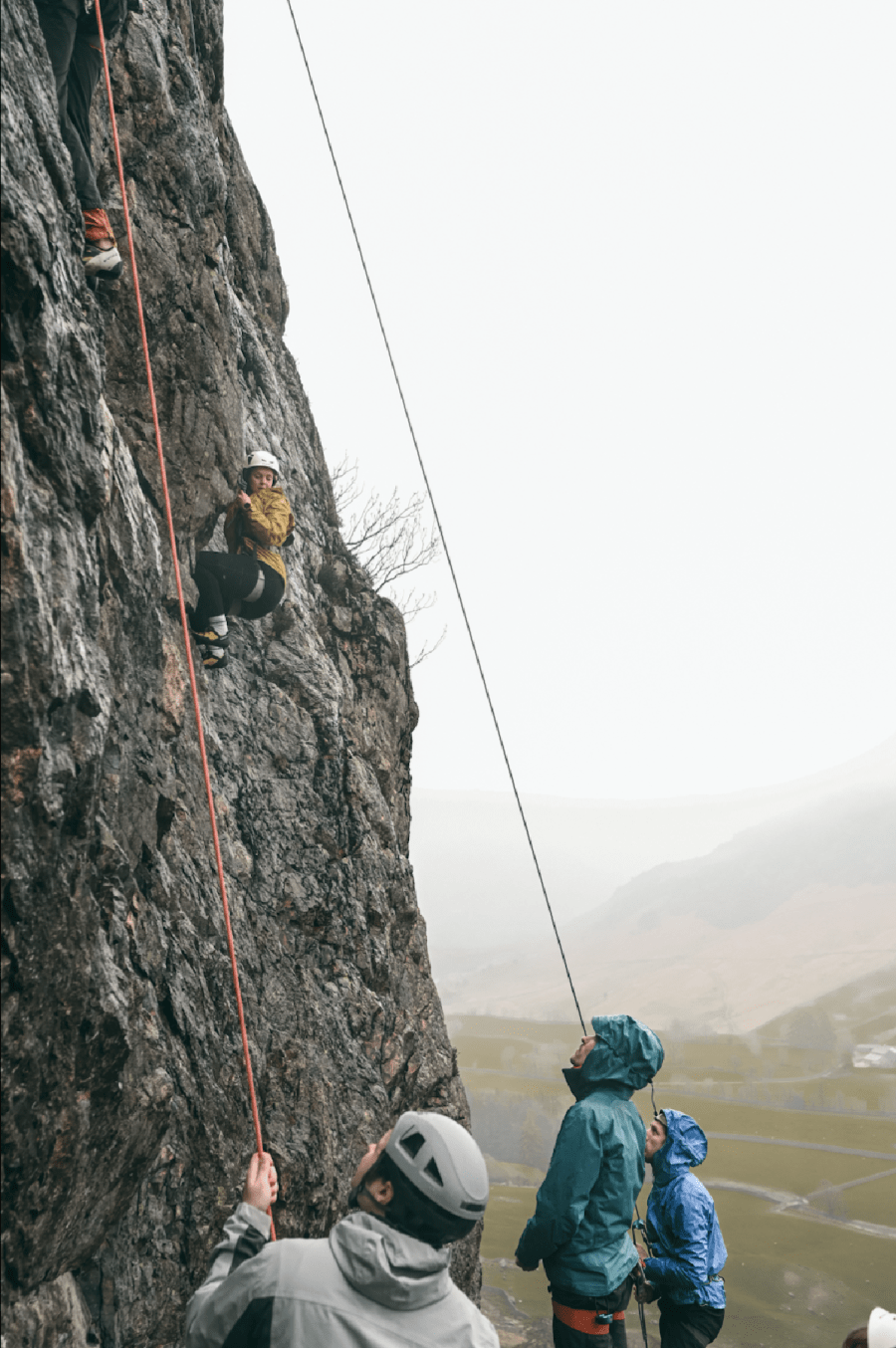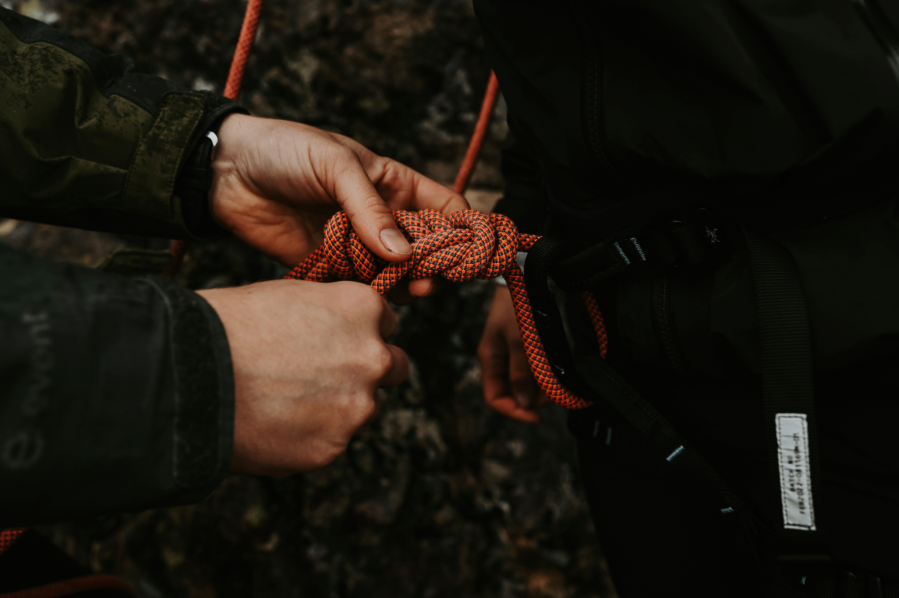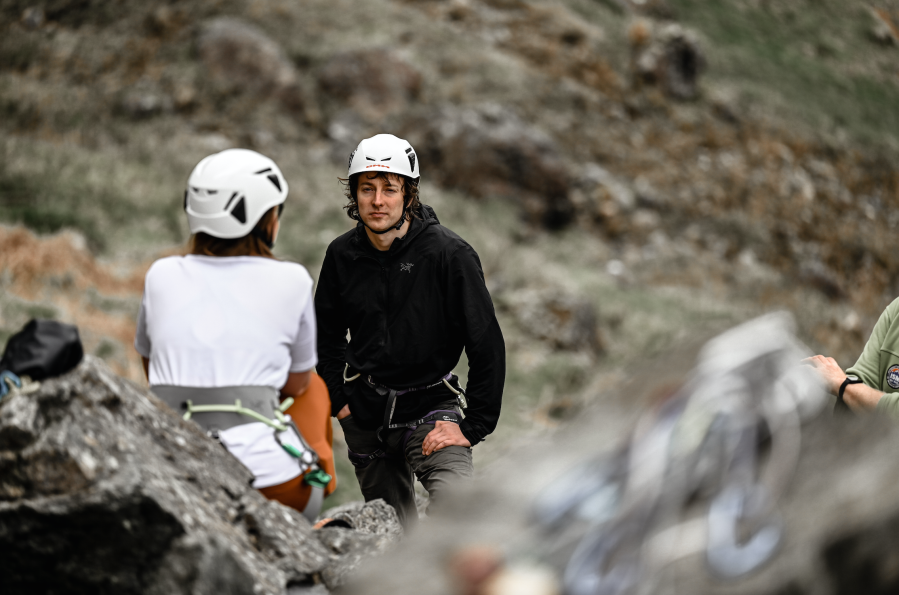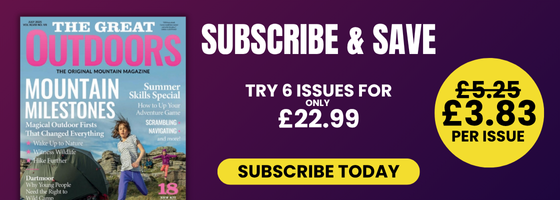Francesca Donovan thought of herself a ‘non-climber’, but after a weekend hanging out – literally – in the Langdales, she shares some confessions of a climbing convert.
Main image: Participants on the women’s Intro to Trad course at the Arc’teryx Climbing Academy in the Lake District. | Credit: Charlotte Bull / Arc’teryx.
My right hand was shaking as I flexed it out, feeling it get clammier by the second as the fingers of my left hand, claw-like, clamped onto rock above me. My legs continued to do a decent impression of a couple of limpets as I forced myself to breathe steadily and cast around for my next move.
It was a drizzly bank holiday with low cloud forecast up hill and down dale across the UK’s high places. I don’t wish to sound ungrateful for the invite to attend the Arc’teryx Climbing Academy, but as a hillwalker who’s in it – at least partly – for summit views, I was secretly delighted to be shipped off for a weekend of climbing in such uninspiring conditions. “Goodie,” I thought, “At least I won’t be missing out on any big mountain day or ‘wasting’ hillwalking opportunities when I’m face-to-face with nought but crag.”

Me, face-to-face with nought but crag.
Credit: Charlotte Bull/Arc’teryx
But here I was, harnessed up and getting high on Scout Crag, staring down rock, helmet knocking into overhang more times than I’d care to admit – and exhilarated to the point of elation. Breathe, foot shuffle, grasp at rock, stare at rock, repeat. Fall, hang out a while, chat with the woman I’d never met who was ultimately responsible for my safety down below on belay. Try again, get a little higher, curse lack of finger strength, descend to terra firma, huge grin splitting my face.
Looking across to Lingmoor and its neighbours, I expected to wish I was walking among the fells. But I found I was quite happy admiring them from afar on our little crag. Frankly, it was energising to look across the Langdale Valley – a place whose lumpy fells I’ve come to love over the years – from this new perspective. Whole climbing guidebooks are dedicated to this area of the Central Fells, full of south-facing crags just minutes from the roadside I’d never explored before. A different world awaits those willing to travel upwards on rope rather than traverse across on foot.
I didn’t expect this realisation to dawn on me so quickly – within my first few hours of climbing, in fact – mainly because it’s bloody hard work.

Hanging out – quite literally – with a little help from my new friends.
Credit: Charlotte Bull/Arc’teryx
Despite my willingness to jump on any excuse to spend more time outdoors, climbing has never been high on my agenda. I like the constant forward motion of a good circular hike or the chance to pick a pace and stick to it stubbornly until you reach the top, going slow enough to enjoy the views while progressing the mileage, litter-picking along the way. I like paddleboarding to new, otherwise-unreachable bays in Pembrokeshire. I like the feeling of swimming across a deep tarn, telling myself to kick my feet so the imaginary creatures I’ve conjured lurking in the deep can’t nibble my toes. I like feeling wind rush past my face and the ground shift beneath a pair of fat wheels on fast descents. I like moving through the outdoors.
So, I guess, I’ve never seen climbing as a means to commune with nature. I’ve read the books, I bought the (barely worn) shoes, I paid a monthly membership to my local wall. But after a few half-hearted attempts at bouldering I still didn’t “get” it. I thought it was too static. Too confined to one place. Too indoors. Too inward-looking. Too human-centric and challenge-focused. Too intense. Too much safety equipment. Too dependent on strength and technique.
Spoiler: I was wrong.

The women-only Intro to Trad course climbed the crag next to ours; aspirational to a novice like me.
Credit: Charlotte Bull/Arc’teryx
Needless to say, as a proud member of the out-of-breath hiking club, I was nervous to spend a weekend at climbing clinics among people fitter, faster and more skilled than me. I’d never climbed with rope at a gym – let alone outdoors.
But during the two beginners’ clinics I attended, I broke down some personal barriers I didn’t even realise I’d put up. Firstly, the equipment. I have loved the simplicity of going out for a walk in need of little more than a decent pair of boots and a waterproof. And yet, it wasn’t long until I had the magic 8 knot – which seems to be almost everyone’s favourite knot (don’t get them started on bollins) – down. As one of my instructors from DMM Wales showed me, it’s really rather easy. You loop the rope around to “make a head, strangle it, and then poke it in the eye”, he explained. Simple. Effective. Safe… for everyone except your newly expired rope pal.

Meet the magic 8 knot.
Credit: Charlotte Bull/Arc’teryx
I learned new lingo and made new friends: “tweaky”, “reachy” and Snow White’s five other companions. I was taught how to manoeuvre my foot into a ‘smear’ on the rock by flattening it into some semblance of stability. Slightly distracted by some of the terminologies after bagging a VD (‘very difficult’) route, I made a mental note to check in with my docs and book a pap.
After my first morning clinic, my hands were sore but my head was full of new ways to commune with the outdoors. In search of some muscle relaxation, I walked up from base camp at Sticklebarn to one of the Stickle Ghyll plunge pools for a dip and a free sports massage courtesy of one of mother nature’s mini waterfalls.
Refreshed, it was time to hit the GORE-TEX tent and give some of my old gear its own dose of TLC. After a quick zip repair, I refuelled with a jackfruit and slaw bap and stayed up late listening to music and enjoying a beer or two.
Day two started wet. After breakfast and a cursory glance at the forecast, it seemed it would only get wetter. Too wet for bouldering, anyway, which was to be the subject of my second clinic. I was quite hopeful climbing would be a fair weather sport and I’d have an excuse to rest my previously unused shoulder muscles. Alas, there’s always more top rope practice to be had in the epicentre of England’s climbing hub.

The walk up to the crag loosened up my tired legs.
Credit: Charlotte Bull/Arc’teryx
Tired arms aside, I immediately cheered up as our group headed past Old Dungeon Ghyll, thoughts of pints later at the forefront of my mind. That was, until we started ascending a meandering rocky path up to East Raven crag and the rain made the gorse glow a brighter yellow than I’d ever seen before. All thoughts of the great, dry indoors quickly slipped away.
The conversation at the crag was constant. Chatter flowed from knots to injuries to the challenges people can face outdoors from racist abuse to imposter syndrome. I bonded with a young boy over our dogs; a man who has climbed my favourite cave in the Peak; a woman over our thick thighs and our sympathy for the two men trying to help fit all the differently-proportioned women at the harness rental stand.

Proud to be a member of the climbing ‘sit club’.
Credit: Charlotte Bull/Arc’teryx
Others told me about how they’d discovered climbing accidentally through a friend or partner years ago, fuelled by the surge in popularity of climbing centres, but had never actually climbed outdoors. A former city-dweller myself, it was wonderful to be surrounded by others who are new to the outdoors as opposed to the long line of folk who were born into adventure you often meet at outdoor festivals.
As rain lashed at our faces, I did wonder if they were now regretting the choice to venture outside but, of course, everyone was abuzz with the challenge of picking from plentiful placements on rock shaped over centuries, puzzling their way through multiple attempts, rather than following brightly colour-coded routes at the climbing gym.
So what of the difference between climbing indoors and outdoors, I asked. “It’s not easier or harder – just different,” they repeatedly told me during my breaks on terra firma. I’m not sure I’ll be rushing to sign myself back up to a gym, but I can certainly see the appeal of climbing outdoors as another way to commune with nature, to understand its geology a little better, to eat nice food in nice places and get to hang out – quite literally – with nice people.

Amal was all smiles on the crag.
Credit: Charlotte Bull/Arc’teryx
Hillwalking is a sometimes solitary affair – that’s often how I like it. But with the support of my new climbing companions, I was making moves I’d never imagined possible with my tight hip flexor and weak upper body. Calls from the ground helped me place my feet and reach higher than before and, back on solid ground, I realised climbing is a team effort. A group sport where your triumphs, both mental and physical, belong to you. But you also get to take them back down to the ground and show them to your climbing companions below. For someone constantly battling an inner monologue of self-doubt, there’s pure joy in sharing in this kind of validation.
Admittedly, I was still delighted when I had to whip out the OS maps app to double-check the possibility of a potential shortcut down from East Raven. You can put a hillwalker in a harness and take her out climbing but old habits die hard.








